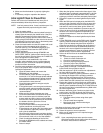
7800 SERIES RM7824A RELAY MODULE
65-0155—1
14
• Hot refractory hold-in test—all installations.
• Ignition spark pickup—all installations using Ultraviolet
Flame Detectors.
• Response to other ultraviolet sources—all installations
using Ultraviolet Flame Detectors.
• Flame signal with hot combustion chamber—all
installations.
• Safety shutdown tests—all installations.
See Fig. 13 for location of component parts and see Fig. 6 or
Q7800 Specifications for terminal locations.
Preliminary Inspection
Perform the following inspections to avoid common problems.
Make certain that:
1. Wiring connections are correct and all terminal screws
are tight.
2. Flame detector(s) is clean, installed and positioned
properly. Consult the applicable instructions.
3. Correct combination of amplifier and flame detector(s)
is used. See Table 2 in the Specifications section.
4. Plug-in amplifier is securely in place.
5. Burner is completely installed and ready to fire; consult
equipment manufacturer instructions. Fuel lines are
purged of air.
6. Combustion chamber and flues are clear of fuel and
fuel vapor.
7. Power is connected to the system disconnect switch
(master switch).
8. Lockout switch is reset (push in reset pushbutton) only
if the RM7824A is powered. See Fig. 1 and 2.
9. System is in the STANDBY condition. POWER LED is
energized.
10. All limits and interlocks are reset.
Table 6. Flame Signal (See Fig. 15).
a
This minimum or a stronger signal should be easily obtained if the detector is correctly installed and positioned to properly
sense the flame. This voltage must be obtained before completing checkout.
b
The flame signal amplifier circuitry is tested one-half second every five seconds during burner operation and shuts down the
burner if the amplifier fails (all installations).
c
The amplifier is an AMPLI-CHECK™ type.
Flame Detector Flame Signal Amplifier
Minimum Acceptable
Steady dc Voltage
a
Maximum Expected
dc Voltage
C7024E,F R7824C
b
1.25 Vdc
5.0 Vdc at the Keyboard Display Module or
C7015A R7848A,B
c
5.0 Vdc at a 20K ohm/volt voltmeter.
Flame Signal Measurement
Measure the flame signal at the appropriate times defined in
the following checkout tests. Read the flame signal volts dc at
the flame amplifier test jacks (+) and (-) (Com).
1. Use a 20K ohm per volt voltmeter with a 0 to 30 Vdc
capability.
2. Set the voltmeter to the 0 to 10 Vdc range.
3. Insert the positive (red) probe into the (+) jack of the
flame amplifier and the negative (black) probe into the
( -) (Com) jack of the flame amplifier (see Fig. 16).
4. Allow a few seconds for the meter reading to stabilize.
5. When using a shutter check amplifier, read the average
stable voltage, disregarding the peaks and valleys
caused by the self-checking program.
6. The meter reading must be as specified in Table 6 after
all tests are completed and all adjustments are made.
As an option, the flame signal can be checked by using the
optional Keyboard Display Module.
If the signal is unstable or less than the minimum acceptable
voltage, check the flame detector installation and circuitry.
1. Check the supply voltages at terminals 3 and L2 (N).
Make sure the master switch is closed, connections are
correct and the power supply voltage is correct.
2. Check the detector wiring for defects including:
• Deteriorated wire.
• Incorrect connections.
• Leakage paths caused by moisture, soot or
accumulated dirt.
• Open circuits.
• Short circuits.
• Wrong wire type.
3. For all optical detectors, clean the detector viewing
window and inside the sight pipe as applicable.
4. With the burner running, check the temperature at the
detector. If it exceeds the detector maximum rated
temperature:
• Add a heat block to stop conducted heat traveling
up the sight pipe.
• Add a shield or screen to reflect radiated heat.
• Add cooling (refer to sight pipe ventilation in the
detector instructions).
5. Make sure that the flame adjustment is not too lean.
Fig. 16. Flame signal measurement.
NEGATIVE (-)
METER LEAD
POSITIVE (+)
METER LEAD
ONE
MEGOHM/VOLT
METER
M7382


















